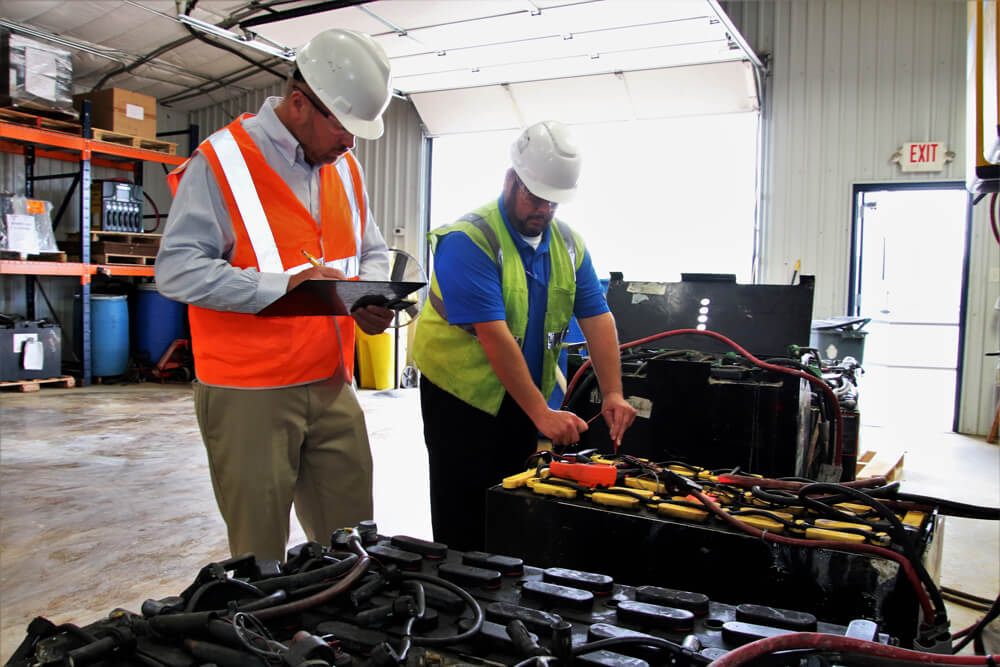It’s hard to find an industry-grade warehouse that is not equipped with a forklift. Their uses are prevalent across multiple sectors of industry. It’s become such a critical component of everyday operations that if one were to break down, it could cause significant delays. However, since they are so commonplace, it’s easy to become complacent and assume that they will always function properly
Lack of attention to detail can frequently lead to accidents in the workplace, becoming an Occupational Safety and Health Administration (OSHA) nightmare. Whether a neglected forklift results in damage to product, severe injury, or even death, many of these incidents can be easily averted with the use of a forklift checklist.
Today, we’re going to cover what should be included in a forklift inspection and how to draft a lift truck safety checklist specific to your industry.
The Value of Machinery Inspections and Checklists
According to OSHA, companies who have forgone the forklift operator daily checklist have led to an average sum of 100 worker fatalities every year. This figure doesn’t include the over 20,000 serious forklift injuries that occur annually. The unfortunate truth of the situation is that many of these injuries could be avoided by adhering to a forklift daily checklist. It’s unlikely you’ll find a forklift that hasn’t been designed and manufactured to industry standards in terms of load and safety. However, without following a carefully constructed forklift inspection checklist, an accident can happen at any time.
In 1970, President Richard Nixon signed the OSH Act, which led to the creation of the OSHA. Since then, OSHA has taken measures to ensure workers can operate without fear of being exposed to known dangers. One way it has implemented its requirements into practice is by mandating a daily pre-shift forklift inspection report (OSHA 1910.178(q)(7)).
By following a forklift inspection sheet, you can identify many of the easily noticed faults found in a forklift that is bound to fail. By completing the daily duty of a forklift checklist, you can avoid becoming a statistic of a poorly documented or neglected forklift. Aside from keeping the safety of yourself, your co-workers, and any nearby pedestrians in mind, by performing a forklift checklist, you can also avoid the hefty fines imposed by OSHA due to an improper evaluation of the equipment you’re using.
Draft Your Own List vs. Using an Existing List
While you and your team may have conducted forklift inspections for years, you may want to revise your list to ensure it’s still up-to-date.
You can find premade ones, such as the Toyota forklift inspection checklist, or you can draft your own. Even if you decide to pull from the Toyota forklift checklist PDF, take steps to ensure it’s in line with the make, model, and purpose of the forklift you’re operating. This way, you know you can rely on your tools to operate as intended, and you can avoid any issues concerning the regulatory bodies overseeing your work.
How to Draft Your Own Forklift Checklist
Creating a daily forklift checklist that your operators perform before their shift begins can have a significant impact on your work environment and your co-workers. With a standardized checklist established, anytime a new operator takes control, they can do so without worrying whether the machine needs maintenance. By following the forklift checklist, you can also reduce the likelihood that a major repair needs to be conducted as you can identify the fault through early detection.
When drafting a new forklift checklist, your starting point should be the unit’s Operation and Maintenance Manuals (OMM). The OMM will detail which items require daily attention. The most common items to include are:
- Newly developed wear and tear or damages
- Indicators that the unit may eventually suffer from faulty operation
- Any damages that could lead to a reduction in performance
- Signs of fluid leakage
- The functioning of accessory equipment, such as lights, alarms, and the horn
When you create an environment of safety, using a forklift checklist won’t become a complacent activity. This task will become a critical component to keeping your employees safe and secure.
Inspection
While your specific forklift checklist will depend on the model you’re operating, the inspection process should be incorporated into the company’s standard operating procedure (SOP). When developing the new SOP regarding the inspection forklift checklist, ensure you include the need to:
- Examine and notate the fluid levels (brake, engine oil, transmission, and radiator fluid level)
- Check the batteries have been properly charged
- Ensure batteries are free from corrosion and are clean and dry
- Maintain the correct water level needed for the battery
- Schedule weekly or bi-montly battery water level maintenance
- Observe if there are any leaks or visible cracks
- Notate the condition of the tires and check the pressure
- Test the lights and horn
- Inspect the controls and gear shifts
- Visually check the lift system (chains, cables, and forks shouldn’t be checked by hand)
- Test the mast chain tension
- Ensure the steering is handling correctly
- Make note that the overhead guard is free from damages
- Check that propane tanks are in working condition
- Test that the seat belt is functional
- Check to see if all signage is legible
- Ensure lift is free from garbage and debris
Contact Texas Motive Solutions to Learn More
To learn more about implementing a forklift checklist, contact Texas Motive Solutions. We are the exclusive provider of Hawker Powersource, Inc. industrial motive battery sales and service solutions to forklift dealers and warehouses in Texas. We take pride in delivering high-end sales, service, and technical support. Trust Texas Motive solutions with all your forklift needs.



